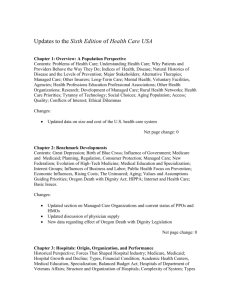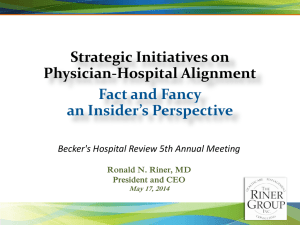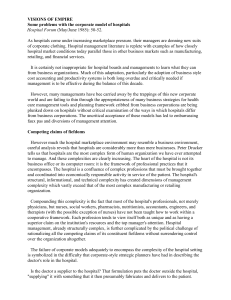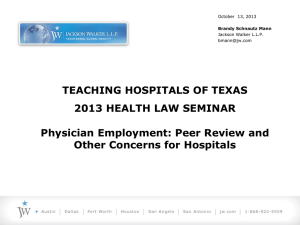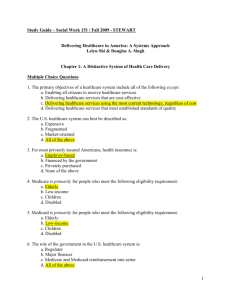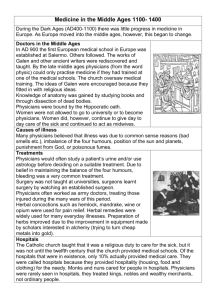The market for health care: An overview
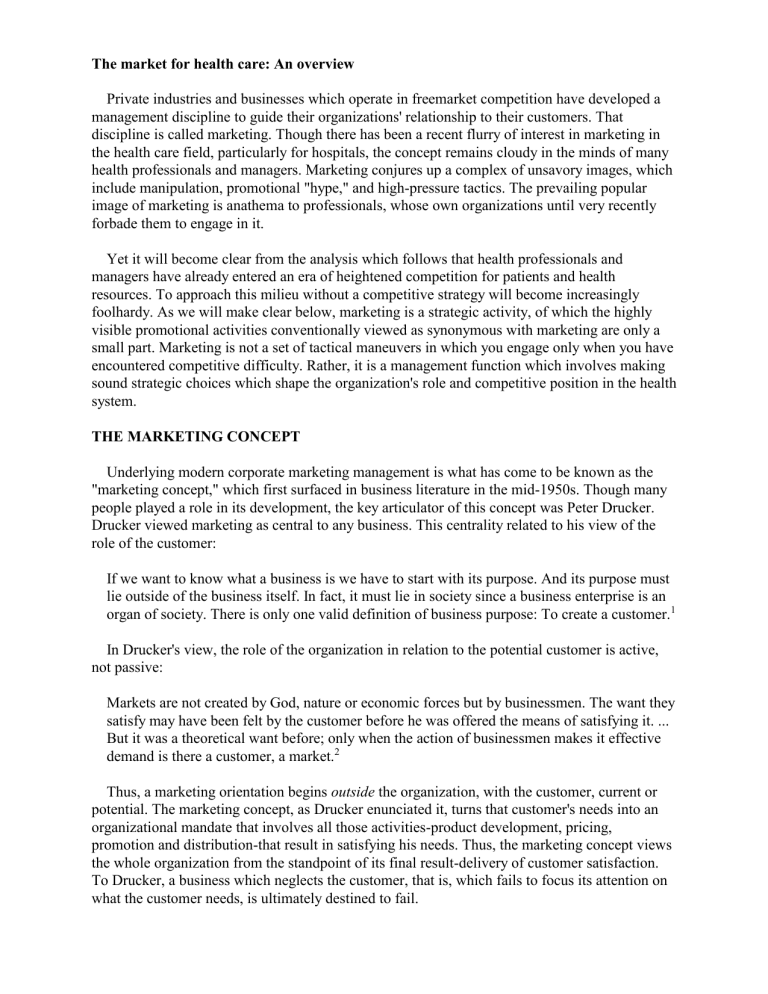
The market for health care: An overview
Private industries and businesses which operate in freemarket competition have developed a management discipline to guide their organizations' relationship to their customers. That discipline is called marketing. Though there has been a recent flurry of interest in marketing in the health care field, particularly for hospitals, the concept remains cloudy in the minds of many health professionals and managers. Marketing conjures up a complex of unsavory images, which include manipulation, promotional "hype," and high-pressure tactics. The prevailing popular image of marketing is anathema to professionals, whose own organizations until very recently forbade them to engage in it.
Yet it will become clear from the analysis which follows that health professionals and managers have already entered an era of heightened competition for patients and health resources. To approach this milieu without a competitive strategy will become increasingly foolhardy. As we will make clear below, marketing is a strategic activity, of which the highly visible promotional activities conventionally viewed as synonymous with marketing are only a small part. Marketing is not a set of tactical maneuvers in which you engage only when you have encountered competitive difficulty. Rather, it is a management function which involves making sound strategic choices which shape the organization's role and competitive position in the health system.
THE MARKETING CONCEPT
Underlying modern corporate marketing management is what has come to be known as the
"marketing concept," which first surfaced in business literature in the mid-1950s. Though many people played a role in its development, the key articulator of this concept was Peter Drucker.
Drucker viewed marketing as central to any business. This centrality related to his view of the role of the customer:
If we want to know what a business is we have to start with its purpose. And its purpose must lie outside of the business itself. In fact, it must lie in society since a business enterprise is an organ of society. There is only one valid definition of business purpose: To create a customer.
1
In Drucker's view, the role of the organization in relation to the potential customer is active, not passive:
Markets are not created by God, nature or economic forces but by businessmen. The want they satisfy may have been felt by the customer before he was offered the means of satisfying it. ...
But it was a theoretical want before; only when the action of businessmen makes it effective demand is there a customer, a market.
2
Thus, a marketing orientation begins outside the organization, with the customer, current or potential. The marketing concept, as Drucker enunciated it, turns that customer's needs into an organizational mandate that involves all those activities-product development, pricing, promotion and distribution-that result in satisfying his needs. Thus, the marketing concept views the whole organization from the standpoint of its final result-delivery of customer satisfaction.
To Drucker, a business which neglects the customer, that is, which fails to focus its attention on what the customer needs, is ultimately destined to fail.
The market for health care: An overview
In a famous Harvard Business Review article entitled "Marketing Myopia,'
3
Theodore Levitt extended the marketing concept by examining the history of businesses, indeed whole industries, which failed because they took the customer, and implicitly, the market for their products, for granted. Levitt saw the definition of a firm's "business" -- its purpose -- not as static but as constantly changing as the society and its needs change.
Since organizations develop bureaucratic inertia, they mistakenly assume that the market for their product will not change and that the job of the organizations is to "produce" and "sell" the product. In a production-oriented business, the marketing task is to sell the firm's output. Selling is not marketing. Selling takes the product and demand for it for granted. Marketing realizes that the demand for any product is likely to change as the customer's needs change and that innovation is essential to keep pace with changing social needs. Levitt extended Drucker's core concept of the need to define one's business in terms of the customer into a mandate, even an imperative, for organization renewal.
Thus, a commitment to the concept of marketing implies a willingness to re-examine the purpose of the business more or less continually and to alter the organization and its products to respond to changing needs. Marketing-oriented organizations are continually evaluating their image, products, and philosophy in terms of the customer's needs and perceptions. Many of the nation's commercial success stories of the postwar era -- Eastman Kodak, Polaroid, IBM,
McDonalds, Procter and Gamble, Revlon -- were preeminent marketing companies which put this concept of marketing into practice.
Philip Kotler of Northwestern University is generally credited with broadening the marketing concept to non-business applications in a 1969 article in the Journal of Marketing.
4
He followed this article with the publication of a text, Marketing for Nonprofit Organizations, in 1975.
5
His generic definition of marketing covered activities in both the business and non-business sectors:
Marketing is the analysis, planning, implementation, and control of carefully formulated programs designed to bring about voluntary exchanges of values with target markets for the purpose of achieving organizational objectives. It relies heavily on designing the organization's offering in terms of the target markets' needs and desires, and on using effective pricing, communication and distribution to inform, motivate, and service the markets.
6
For our purposes, however, we will define marketing in simpler terms: Marketing is all those activities which involve creating, sustaining, and managing the demand for what an organization produces. The key concepts here include defining an organization's "product" and conceptualizing the "demand" for it, which inevitably is generated by some groups or group outside the producing organization. The idea that organizations can manage demand is the most important part of the definition and is likely to be mildly counterintuitive both for health care professionals and managers.
THE APPLICABILITY OF THE MARKETING CONCEPT TO HEALTH CARE
The management tasks of any service organization, profit or nonprofit, are more complex than for a typical manufacturing enterprise. The "product" of most service enterprises is intangible.
One cannot store, stack or count, or drop-ship "health" or "financial security." Thus, many of the
marketing technologies of industry, particularly those which relate to logistics, laboratory research and development, and physical distribution, do not apply to most service industries.
Further, because the product is intangible, it is difficult to measure productivity in the sense of definable, manageable relationship between input (labor and goods) and output (product). While it is inherently more difficult to manage service organizations for productivity, as will be seen later, it is eminently possible.
Because they tend to be dominated by professionals whose primary commitment is to their own professional practices, health care enterprises and their managers tend to be production-oriented. That is, they take the organization's current service offerings, and their quality, accessibility, and other important variables, for granted. To the extent that they engage in marketing activities, they tend to be oriented toward selling the product to a customer whose needs are, more often than not, defined in a self-serving way.
The market for health care: An overview
While this orientation is unlikely to be problematical in a sellers market, where providers of health care are in short supply, it may be disastrous in increasingly competitive markets. While the relationship of a physician to a patient may generate personal satisfaction, professional rewards flow from peers not from patients. Further, physicians may be specifically concerned if the hospital at which they practice mismanages their own patients and are more likely to judge a hospital by how well it serves their needs than by how well it serves their patients' needs. Unless directly threatened economically, individual physicians are likely to have no interest in whether their hospital's "market share" is slipping.
Health care is not a commodity; it is the most intimate personal service. The personal nature of the transaction between physician and patient, and the fact that most such relationships (except for family practice) involve the physician in seemingly isolated dyads (pairs), obscures the underlying similarities between patients. The similarities between one physician's practice and another's are likely as well to escape notice. Underlying this fragmentation are some common concerns, however.
Patients expect their physician to be reasonably accessible, and they expect to trust his or her medical judgment in managing their illnesses. They also have some concerns about the reasonableness of the fee, since they are likely to bear a greater portion of that cost than for other services. They expect some reasonable congruence of moral values and attitudes toward some forms of medical treatment (abortion, for example). They expect the relationship to be confidential. Indeed that confidentiality is often a precondition to effective diagnosis of any illness. Any of these expectations may be disappointed, of course, and may lead the patient to seek care elsewhere.
Thus from the patient's point of view, the physician's product is effective, sound, medical management, delivered with competence and concern. In general, physicians do relatively little actively to build their medical practices beyond trying to care competently for existing patients, relying on word-of-mouth and personal contacts to provide new patients. Because until recently physicians have operated in a seller's market, they have not had to concern themselves seriously with feedback from patients.
From a hospital's perspective, the core market is the physicians who practice on its medical staff. Though hospitals have relatively recently begun to dilute their risk by providing pathways into the hospital (emergency room, problem clinics, etc.) which do not require direct physician mediation, hospitals must rely on their medical staffs to bring in the vast majority of patients.
The two mediating variables which govern hospital utilization are the vitality of the physician practices of medical staff members and the share of hospitalization of the physician's patients that she or he chooses to bring to the particular hospital. Thus, the true market for hospital services is the physician.
However, to serve the physician effectively, the hospital must do two things: meet the physician's needs for efficient service and support for his or her medical activity and meet the patient's needs for convenient, quality hospital care. For hospitals which have extensive referral practices, such as tertiary level teaching hospitals, the patient's family physician, who refers the patient to a specialist who manages the care in-house, must also be accommodated.
In the first instance, application of the marketing concept to the hospital requires a responsive relationship between hospital administration and the medical staff. However, the matrix relationship between hospital administration and medical staff (dual lines of authority which must act in an interdependent fashion), poses the problem of where to lodge the responsibility for looking beyond the hospital's current programs to define future organization. Since physicians control utilization, marketing cannot be exclusively an administrative activity. Because medical practices are isolated from one another, it is frequently difficult to get physicians to view the medical needs of the community as a whole. These factors inhibit the development of a marketing orientation in hospitals but do not excuse the failure to adopt it. When the hospital begins losing money it becomes easier to get everyone's attention. Unfortunately, by then it is often too late to solve the problem.
THE SPECIAL ROLE OF THE HOSPITAL
In order to understand the importance of a marketing orientation for health care providers, it is essential to understand the structure of the health care market. Because the largest single segment of that market is the hospital industry, exploring the demand for hospital services is the best place to begin.
The hospital is the institutional core of the nation's health care system. It is the focal point for the community's physicians, as well as a powerful social and political institution. The hospital is also the most capital-intensive (and capital-hungry) component of the health care system, a fact which will loom ever larger as the cost of capital continues to escalate. Originally, hospitals were charitable institutions, built in the best American tradition through acts of private philanthropy and, subsequently, through public works. These charitable origins account for the not-for-profit status of most of the nation's hospitals.
However, beginning in the 1930s with the founding of Blue Cross plans and accelerating in the 1960s with the enactment of Medicare and Medicaid, an increasing amount of health care and virtually all hospital care, became covered by some form of health insurance. Stimulated by the increasing breadth of coverage and fed by rising demand for health care as almost an entitlement, the hospital industry in the United States has grown into a major economic force.
Hospitals accounted for $85.3 billion in expenditures during 1979, fully 40 percent of the nation's total health care spending.
7
This amount will certainly exceed $100 billion in 1981.
There were 6,988 hospitals in the United States during 1979, containing approximately
1,370,000 beds. Of this total, 5,923 hospitals were community hospitals, which accounted for
988,000 of the beds. On any given day, more than I million people awaken in a hospital bed.
8
Source: Reprinted from Jeff Goldsmith, “The Health Care Market: Can Hospitals Survive?” Harvard Business
Review, September-October, 1980. Data for 1967-77: Handbook of Labor Statistics 1978 (Washington, D.C.:
Bureau of Labor Statistics, U.S. Department of Labor); 1978-79 data: phone conversation, Bureau of Labor
Statistics, July 1, 1980.
Given the enormous physical plant and volume of care, it is not surprising that hospitals are among the nation's largest institutional employers, with a work force of almost 3.8 million people
9
and an annual payroll of $41.5 billion. Among the people are almost 81,000 physicians, nurses, and other health care personnel in training.
10
Through the major federal health care entitlement programs, Medicare and Medicaid, government has become the largest purchaser of hospital services. Almost 35 percent of the
nation's hospital bill is paid for by the Medicare and Medicaid programs.
11 Government also exercises a major role as a direct provider of hospital care through the Veterans Administration hospital system, armed forces hospitals, state mental-hospital systems, and local public/general hospitals, though this role has been declining in recent years. Total government outlays for hospital care, for direct service, and through third-party payment, total $47.7 billion, or 56 percent of the total hospital bill in 1979.
12
Because government pays so much of the nation's hospital bill, government budgets are sensitive to rising hospital costs. As can be seen from Figure 1-1, for most of the last 15 years hospital costs have risen much more rapidly than the rate of general inflation in the U.S. economy.
Since 1965 hospital spending increased from $13.9 billion to over $85 billion in 1979 (see
Figure 1-2).
13
Hospital spending thus accounted for 42 percent of the total increase in health care spending since 1965. By 1979 hospital expenses accounted for 74 percent of total Medicare spending and 36 percent of Medicaid spending.
14
Hospitals have supplied the largest aggregate spending pressure on federal and state health care programs.
Since Medicare and Medicaid spending play a major role in federal and state budgets, hospital cost increases have become a political issue. They played a major role in precipitating financial crises in New York City and in the states of Massachusetts and Illinois during the 1974-75 recession. As a result, there has been an escalating effort at the federal, state, and local levels to contain hospital costs.
Efforts to secure direct federal cost controls on hospitals during the Carter administration were rebuffed by Congress. Thus, most federal efforts have focused on the so-called Health Planning program, and most state efforts on public utility-style hospital rate review.
CONTROL OVER HOSPITAL-BED SUPPLY
Federal health policy during the post-World War II period has been characterized by a broad swing from active federal encouragement of expanded hospital-bed supply to active federal efforts to reduce supply. In 1946, with strong rural backing, Congress enacted the Hospital
Survey and Construction Act, popularly known as the Hill-Burton Program. The purpose of the act was to help assess areas of hospital under-service in the country and to provide federal matching grants to construct new hospitals in areas where they were needed. From 1947 to 1971, the federal government committed $3.7 billion in federal funds, which generated a total investment of nearly $13 billion in health facilities through Hill-Burton. The program resulted in the construction of an additional 340,000 hospital beds, mostly in small towns and rural areas.
State Hill-Burton agencies were compelled by the act to assess the need for facilities in their areas in order to secure federal funding. During the early 1960s New York State went beyond
Hill-Burton mandates and established the nation's first Certificate of Need program, which required hospitals to obtain prior approval from a state agency before proceeding with construction. As cost pressures mounted during the late 1960s and early 1970s (especially as a result of the recessions of 1969-70 and 1974-75, which sharply increased state Medicaid outlays for hospitals), more states enacted Certificate of Need laws, until by 1979, 46 states had such legislation.
During the late 1960s, federal policymakers began to view the fragmentation of the health care system as an increasing problem. Through the Partnership in Health Act of 1966 they created a network of voluntary state and local planning agencies to engage in comprehensive regional planning for health care. However, beyond the vague mandate to coordinate federal health resources in given areas, it was far from clear what these agencies intended to accomplish. Given this mandate, it surprised no one that they accomplished very little.
In 1974, facing growing concern over the growth in Medicaid and Medicare spending,
Congress replaced the comprehensive health planning agencies with a new network of agencies which were given a clearer mandate to engage in planning and regulatory activities. Under the
Health Planning and Resource Development Act of 1974, Congress established local health planning agencies called Health Systems Agencies and state health planning agencies, and a set of review functions mandated to "shrink the system." Guidelines issued under this act called for reduction of bed supply in the country to a level of four beds per 1,000 population and the achievement of a variety of more specific objectives.
Underlying the mandate to shrink the system was a theory that if hospital beds exist they will tend to be used. This theory is called the "Roemer effect," after the researchers who documented higher hospital use rates in high-supply areas. To the extent that hospital beds are not used, policymakers argued that the society would pay for allegedly high fixed costs of the unused beds.
The result is a federal policy mandate which can be likened to compelling an overweight person to reduce weight by restricting the size of his clothing. Yet despite the best efforts of a newly created cadre of bureaucrats and self-anointed "healthcare consumers," hospital capacity continued to expand and hospital costs continued to increase. Congressional ardor for the program has cooled considerably, and the Reagan administration has proposed shrinking the health planning system as a fiscal move. There is no compelling (even circumstantial) evidence that the annual federal expenditures in excess of $150 million for each year of the program have returned commensurate benefits to the taxpayer. Fifteen years of experimentation with two versions of health planning have not produced either the coordination or the cost reductions sought.
In fact, by increasing the entry barriers for new hospital providers, regulatory efforts may have hardened the monopoly power of existing providers. Regulatory barriers to outside competitors have substantially strengthened the credit standing of existing providers by assuring bondholders that new competition is unlikely. While retailers who are successful in a given market area have absolutely no assurance that competitors will not set up shop across the street, Certificate of
Need has virtually assured the successful hospital that new entrants will not steal their market.
By enfranchising existing providers, regulation may have protected inefficient providers from better managed competitors.
RATE REGULATION
By the late 1960s states had begun to apply public utility regulation concepts to hospital care through the establishment of state-level rate review. More than two dozen states adopted rate-review mechanisms for hospitals during the 1970s. The results are at best inconclusive.
Though one recent research effort has established that in six states where rate review was well established, expenses per admission rose less rapidly than the national average,
15
this study is clouded by the fact that several of these states, notably New York and Massachusetts, throttled back their Medicaid programs due to fiscal crises during the study period.
Alain C. Enthoven argues that the combination of industry efforts to alter the hospital care base, industry capture of regulators, and perverse incentives of cost control mechanisms may do little to influence hospital costs, let alone to increase hospital efficiency or productivity. As he says:
The general history of economic regulation in our country does not support the presumption that regulation reduces costs to consumers. Indeed, the present moves to deregulate transportation are based on powerful evidence that regulation has raised costs.
16
The burden of proof that extra-market mechanisms are effective in restraining hospital costs remains on those who advocate such approaches. The emerging consensus of health policymakers in Congress and elsewhere is that regulation has failed in other sectors of our economy and has yet to demonstrate significant results in the health care industry.
COMPETITION IN THE HEALTH CARE FIELD
Led by Enthoven and others, health care analysts have focused attention on encouraging competition as a means of increasing efficiency and reducing the rate of increase in health care costs. The existing third-party payment systems have insulated both the consumer and physician from the economic consequences of consuming health care.
However, even those who advocate these competitive approaches to restructuring the insurance system ignore the intense competition which does exist between providers of health care for patients and patient revenues. Much of this competition has focused on convenience to the consumer and physician and the quality and comprehensiveness of care available. However, competition between different modes of delivering health care is a force which many policymakers have ignored, because the trade-offs and competitive relationships between these modes are not clearly understood. Hospital managers and physicians are certainly aware that they operate in a competitive milieu. Mediated by reimbursement policies that govern what insurers are willing to pay for, this competition may, by reducing demand for the most expensive modes of care, ultimately have a much more profound effect on health care costs than regulatory approaches.
DEMAND FOR HOSPITAL SERVICES
As mentioned above, hospitals are the core institutional provider of health care in the United
States. Yet as hospital costs continue to rise and press against the outer limits of taxpayer and insurer willingness to pay for increases, hospitals will become increasingly vulnerable to competition from less expensive and more convenient modes of rendering health care, as well as to wholesale reductions in levels of reimbursement from public health care programs. Much like the urban department store, which faces major competition from alternative retailing modes
(drug store chains, discount houses, direct mail, boutiques, and specialty shops), hospitals face competitive threats from alternative modes of rendering health care, including health maintenance organizations (HMOs), ambulatory surgical centers, freestanding urgent care centers, and ironically, their own medical staffs. Many of the newer forms of care have in common the substitution of outpatient for inpatient care with both cost and convenience benefits to the patients. Other forces, such as the declining use of the hospital for long-term and chronic care, and the growth of mechanisms such as HMOs. which ration hospital care, has also reduced
the demand for inpatient care. New forms of health care will reduce utilization of the hospital's core service line of inpatient care in the next few years, perhaps significantly.
It is impossible to document the extent of these tradeoffs completely. Though a Blue Cross study showed that Blue Cross subscribers used 18.6 percent fewer inpatient days of care and
137.6 percent more outpatient visits in 1978 than they did in 1968, it is impossible to determine how much of this shift was due to changing health status of enrollees or change in the composition of those who are insured.
17
The extent of economic trade-offs between different forms of care can and will be accelerated by growing insurer efforts to make more aggressive use of their medical purchasing power. The impact of this shift in utilization may be that the demand for inpatient hospital care will decline over the next 20 years, even given the projected increase in the elderly population.
Recent hospital utilization data bears out this contention. While community hospital inpatient days increased by 27.5 percent from 1965 to 1975, they have increased by only 2.9 percent in the five years from 1975 to 1979 (Figure 1-3). This is despite the growth in the number of elderly of approximately 2.5 million during the same period. Hospital outpatient utilization appears to have plateaued as well. Outpatient clinic visits increased by only 7.5 percent during this five year period but actually declined by 1 percent during the last two years of the period.
18
Underlying this trend in aggregate hospital utilization is a decline in per capita hospital inpatient use during the same period (Figure 1-4). Average inpatient days consumed per 1,000
U.S. citizens peaked during 1975 at approximately 1, 255. This number has since declined by 2.4 percent. The typical American is consuming fewer hospital days now than five years earlier.
Declines are even more abrupt for the two largest segments of the U.S. population, those under
15 and those between 15 and 44 years of age. Use rates for those under 15 declined by 7.1
percent and for the bracket containing the baby boom population, by 6.8 percent. Though use rates for the elderly seem to be holding firm, (despite the best efforts of the professional standards review organization [PSRO] program), hospital utilization has virtually plateaued in the aggregate for the U.S. population and has declined on a per capita basis in the last five years.
What has produced this development? There are three broad competitive forces (Figure 1-5) which affect the demand for inpatient hospital care and which will exert a major influence on hospital use patterns in the future. They are: the growth and diversification of ambulatory care, the growth of alternative delivery systems including HMOs, and the growth of aftercare for the chronically ill and the elderly. Growth in these alternative modes of rendering health care will reduce the demand for inpatient services in the future.
The first sector, ambulatory care, has both grown and diversified. Spurred by scientific advances and changing medical technology, much care that was rendered inside hospitals 20 years ago can now be rendered on an ambulatory basis. Advances in drug therapy for many mental disorders and development of community-based treatment helped empty out mental institutions. Development of drug therapy for tuberculosis shut down most of the large chronic disease hospitals during the postwar period. Many types of surgery can now be performed without hospitalizing the patient through "day surgery" or ambulatory surgical programs. Many types of emergency care, short of massive trauma, can be rendered outside the hospital in freestanding emergency facilities.
On top of these developments, physicians have developed more complex practice settings which permit them to perform many types of diagnostic work in their offices or group practices, rather than in a hospital. Since physicians control the provision of ambulatory care, they have the ability to redirect the patient from the hospital to office settings they control, and recapture the economic rewards of this care from the hospital. For reasons related to the increasing supply of physicians, the economic pressures on physicians to compete with the hospital will increase in the future. The trends and developments in the physician marketplace and in ambulatory care are discussed at length in the chapter on ambulatory care.
The second sector which represents a significant competitive threat to hospital utilization is that range of services to the elderly and chronically ill known as aftercare. This sector, which comprises residential care in nursing facilities as well as in-home and outpatient care for the elderly, is the most rapidly growing part of the health care system. Much medical care rendered to the elderly may not be most appropriately provided in an acute-care hospital setting. Further, much of the care needed by the elderly may not be medical care at all, but social service, which need not be provided by medical personnel. Federal policymakers have recognized this by encouraging rapid growth, first of nursing facilities and, subsequently, of home health care services over the last 15 years. Growth and development of this sector will be explored in the chapter on aftercare.
The third sector is comprised of the so-called alternative delivery systems, such as HMOs.
More than 9 million Americans are now enrolled in some form of prepaid health plan.
19
Patterned after the successful Kaiser Permanente Medical Care Program of California, health maintenance organizations contract with physicians, hospitals and other providers to render all the health care their members need. Health maintenance organizations charge a fixed fee, determined in advance, for meeting the health care needs of their members and serve as a prime contractor in arranging their care. The prepayment feature, and the fact that illness is a cost to the
HMO rather than potential income to the provider, encourage HMOs to economize in the purchase of medical care. Since HMOs have a major economic incentive to reduce utilization of expensive hospital services and to substitute less costly forms of care if possible, they represent a competitive threat to hospitals. The growth of these systems will be explored in the chapter on alternative delivery systems.
The last 20 years have witnessed dramatic structural changes in the health care system in the
United States. New forms of health care and new systems for providing that care have emerged, encouraged by growth in federal financing of health care but fueled by entrepreneurship, both small scale and large scale. There is intense competition within each of these sectors, as well as between hospitals and alternative modes of rendering health care. This competition will increase in the future.
THE ROLE OF MEDICAL PURCHASING POWER
Only about one third of the nation's health care expenditures, or $60 billion, were made directly by Americans in 1979.
20
The remaining two thirds of personal health expenditures were either generated by government grants and direct delivery by government agencies, or through private health insurance and government health care entitlement programs such as Medicaid and
Medicare. The design of these reimbursement systems has generally accommodated itself to the central role of the physician by separating his reimbursement from that of the hospital, and by reimbursing the hospital for its costs incurred (more or less) as the physician has dictated.
Beginning with professional standards review organizations, however, government and other third party payers have begun to encroach upon the physician's judgment to eliminate medically unnecessary hospital expenditures.
Up to this point, most insurers and payers of health care have attempted to achieve structural change and induce efficiencies in the purchase of care by fostering alternative modes of rendering health care through extension of health benefits to new types of services. Medicare and
Medicaid sought to trade off lengthy hospital stays by creating lower cost extended care facility reimbursement, as well as reimbursement for in-home services. Recent amendments to Medicare and Medicaid laws liberalized reimbursement for ambulatory surgery conducted outside the hospital. Government and private payers have moved cautiously in fostering the growth of alternatives because it is nearly impossible to document the cost-saving trade-offs that may result.
There are signs, however, that the government and insurers may begin to take the alternative approach of being increasingly specific about what they will pay for and in what settings. Several state governments are experimenting with reimbursement of hospitals on the basis of diagnosis, rather than purchase of services on a per diem basis. While the initial intent of the so-called
Diagnosis-based Reimbursement Group (DRG) system is to correct hospital per them costs for the relative sickness (intensity) of the hospital's patients, DRG systems also provide the data base
for deciding whether certain diagnoses will be reimbursed at all in certain settings. Purchase of hospital services on a diagnosis rather than per them basis is expected by policymakers to encourage more rapid discharges and more efficient means of rendering care, because hospital costs will be covered only to a certain point, not ad libitum. This departure from cost-based reimbursement, which is blamed for much hospital cost inflation, could profoundly alter the ground rules under which medical care is rendered and accelerate the trading off of inpatient care against other forms of care.
At the same time, insurers are becoming less willing to pay carte blanche for whatever services may be provided to patients. Blue Cross, for example, has declined to reimburse hospitals for batteries of ancillary tests which are automatically rendered to the patient upon admission to the hospital. The California Medicaid program (MediCal) requires special documentation before it will reimburse inpatient stays associated with certain surgical procedures which can be done on an outpatient basis.
There are political limitations on the ability of government health programs to impinge seriously on the physician's discretion in rendering health care. It is unlikely that the government will be able to alter the fee-for-service reimbursement mode for physicians significantly. At the same time, the fiscal pressures created by public demand for tax relief and increased defense spending will inevitably force federal policymakers to re-examine the effectiveness with which they are purchasing health services for the vast populations of indigent and elderly served by its entitlement health programs. This pressure may result in increased efforts to purchase health care according to more precise definitions of medical needs. Alternatively, it may simply result in initiatives which reduce payment for care by government programs, forcing providers to economize or withdraw from servicing the populations. While the physician may be able to render care and derive income from alternatives, the hospital may be the net loser.
At the same time, private insurers are running out of margin in absorbing increasing hospital costs, and may begin applying increasingly stringent tests of necessity before paying for health care. Insurance policies are likely to become increasingly specific about what types of care will be rendered for what conditions. Increasing selectivity of health insurance benefits will accelerate trade-offs which already exist between more and less expensive modes of rendering health care.
If these trade-offs are aggressively pursued, either through competitive brokering or through increasing specificity of insurance coverage, demand for the most expensive forms of health care delivered in hospitals could be reduced significantly.
THE SPECIAL ROLE OF THE ELDERLY
Though individuals over 65 constitute only about 10 percent of the U.S. population, they consume almost 30 percent of the nation's health resources. This population is expected to grow by almost 25 percent between now and the turn of the century. Many in the hospital industry believe that the growth in the elderly population will mean increasing demand for hospital services, since the elderly currently consume almost four times as much hospital care per capita as the national average.
However, there are two factors that may reduce the aggregate impact of the increasing elderly population on demand for hospital services. First, state and federal budgets are already seriously strained by the combined impact of the growth in elderly population and inflation. It is unlikely that the federal government will continue to be able to pay for four days of hospitalization per
capita for the elderly, and will begin to force trade-offs with aftercare alternatives to hospitalization.
The amendments to Medicare passed by Congress in the winter of 1980 move federal health policy in this direction. First, under certain circumstances, hospitals may be denied hospital-level reimbursement for services rendered to patients who are awaiting nursing home placement but do not need acute medical care. Smaller hospitals are encouraged to develop "swing beds" which can be converted from acute care to long-term care as needed. Second, the amendments liberalized home health care benefits under Medicare and began to loosen some nursing home reimbursement standards as well. While demand for health services for the elderly will undoubtedly increase, how much of this increase will be shared by hospitals remains to be seen.
The second factor which could blunt rising demand for hospital services is the changing health status of the elderly. In a recent article in the New England Journal of Medicine, Dr. James Fries contended that the increases in life expectancy during this century occurred not because of a lengthening of the absolute span of life as much as because of a reduction of premature deaths due to infant mortality, infectious disease, and other acute illness.
21 Fries argues that medical advances and healthier lifestyles (e.g. more exercise, reduced smoking, proper diet, and weight control) will reduce the period of morbidity prior to death by postponing the onset of chronic illness. Fries argues that the mean age at death is biologically fixed. Fries goes on to say,
The social consequences of this phenomenon will be profound. Death and disability, occurring later, become increasingly unavoidable. The incremental cost of marginal medical benefit inevitably rises. Intervention in the patient without organ reserve will be recognized as futile.
22
While it is difficult to imagine patients and physicians abandoning curative approaches to prolonging life, what Fries suggests is that there may be growing acceptance of 66 palliative" care which accommodates to the inevitability of death and that peoples' attitudes toward incurring the expense of acute care will change.
It is impossible to quantify the impact which healthier lifestyles will have on the consumption of health services. But it is becoming increasingly apparent that everyone can have an enormous impact on his or her own health status by proper exercise, diet, and the avoidance of known health hazards such as smoking.* Ultimately, the individual may have more influence on the demand for hospital services than the physician and the insurer together. The healthier the population, the less likely it is to consume as much hospital care as the current elderly population. The corresponding demand of tomorrow's elderly for hospital care will be proportionately diminished.
CONCLUSION
The health care industry in the United States is undergoing profound structural changes which will alter the role the hospital and the physician play in rendering medical care. As this structure broadens and diversifies, alternatives to acute care hospitalization will become increasingly attractive economically. The more rapidly hospital costs escalate, the more rapidly these trade-offs will be forced by health insurers. Just as the rising price of oil increases the economic viability of substitute fuels, the rising price of hospital care will encourage growth of ambulatory services, alternative delivery systems, and aftercare for the nation's elderly. As costs increase, competitive pressures within the hospital industry will intensify to the point where many
hospitals, perhaps hundreds, may be forced to close, and as many as several thousand others may be absorbed by large hospital management firms. Entrepreneurial opportunities will abound in many areas outside the hospital as well.
These developments can only benefit the patient, because it will present him or her with an array of cost-effective, convenient alternatives for receiving health care. As competition for patients increases, both physicians and hospitals, as well as other providers of health care, will be increasingly interested in meeting the patient's needs. The patient will no longer be what one famous health services analyst called the "breathing brick" of the health care system. Consumer sovereignty will be a watchword of the competitive health care system.
* These factors may already account for the declining per capita consumption of hospital services among the 15 to 44 age group discussed above.
NOTES
1. Peter F. Drucker,
2. Ibid.
The Practice of Management (New York: Harper & Row, 1954), p. 37.
3. Theodore Levitt, "Marketing Myopia," Harvard Business Review, September-October 1975.
4. Philip Kotler and Sidney 1. Levy, "Broadening the Concept of Marketing," Journal of
Marketing 33 (January 1969).
5. Philip Kotler, Marketing for Nonprofit Organizations (Englewood Cliffs, N.J.: Prentice-Hall,
1975).
6. Ibid.
7. Robert Gibson, "National Health Care Expenditures: 1979," Health Care Financing Review,
Summer 1980, p. 17.
8. American Hospital Association, Guide to the Health Care Field, 1980 (Chicago: American
Hospital Association, 1980), p. 4.
9. United States Department of Health and Human Services, Public Health Services, Office of
Health Research, Statistics and Technology, Health United States 1980 (Washington, D.C.:
U.S. Government Printing Office, 1980).
10. American Hospital Association, Guide to the Health Care Field, 1960, p. 4.
11. Gibson, "Health Care Expenditures," p. 29.
12. Ibid.
13. Ibid., p. 32.
14. Ibid., p. 29.
15. Brian Biles, Carl 1. Schramm, and 1. Graham Atkinson, "Hospital Cost Inflation Under State
Rate Setting Programs," New England journal of Medicine 303, no. 12 (September 18,
1980): 664-67,
16. Alain C. Enthoven, Health Plan (Reading, Mass.: Addison-Wesley Publishing, 1980).
17. Blue Cross and Blue Shield Associations, "Blue Cross Plans Experience Sharp 10-Year
Decline in Hospital Utilization Rate," press release, January 18, 1980.
18. American Hospital Association, Hospital Panel Survey 1980 (Chicago: American Hospital
Association, 1980).
19. "July 1980 Survey Results: HMO Enrollment and Utilization in the U.S." (Excelsior, Minn.:
Interstudy, July 1980).
20. Gibson, "Health Care Expenditures," p. 29.
21. James F. Fries, "Aging, Natural Death, and the Compression of Morbidity," New England
Journal of Medicine, July 17, 1980, pp. 130-35.
22. Ibid.
